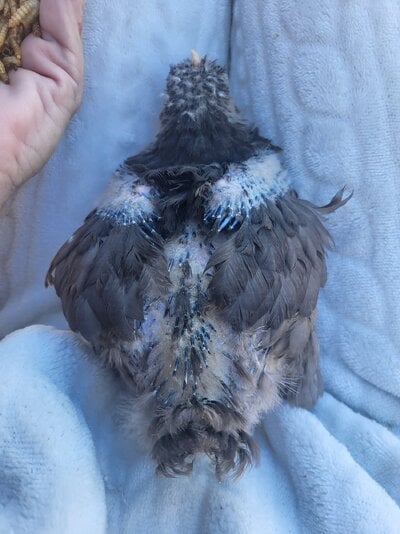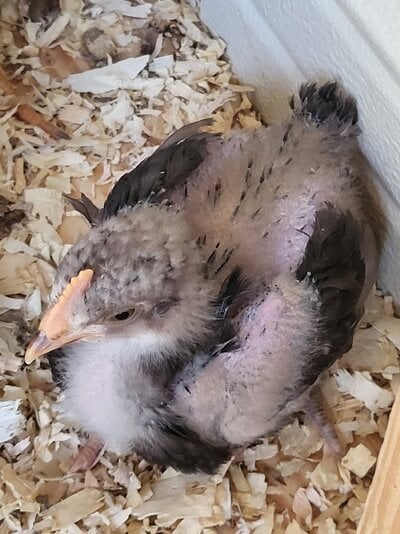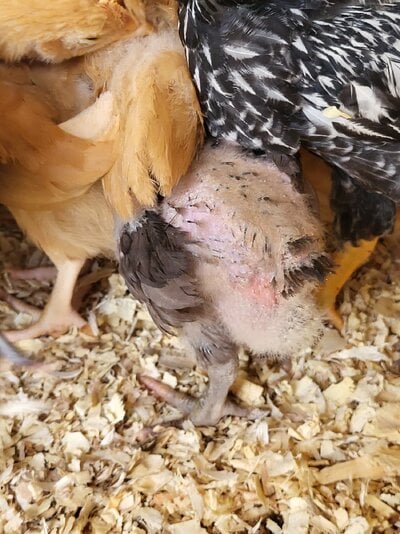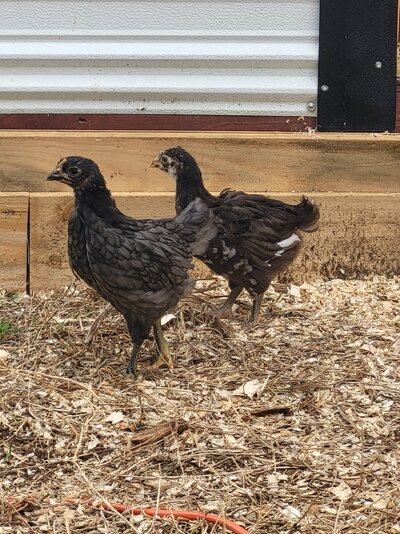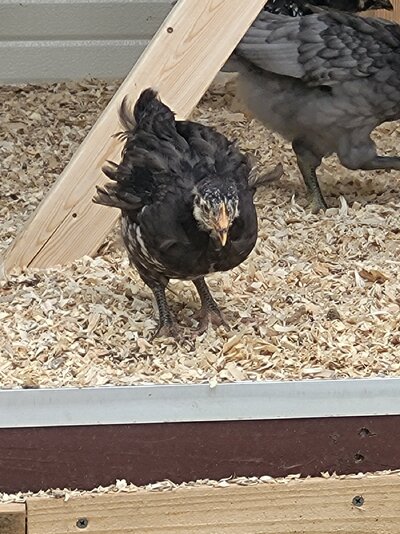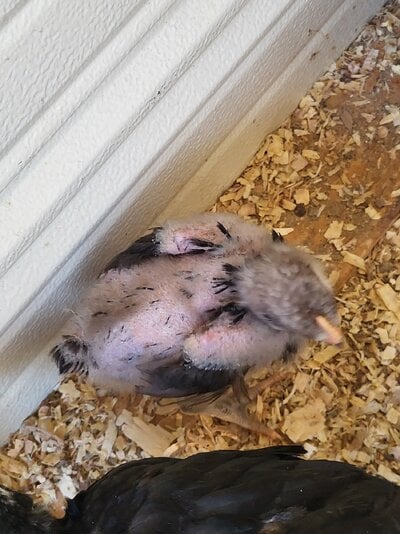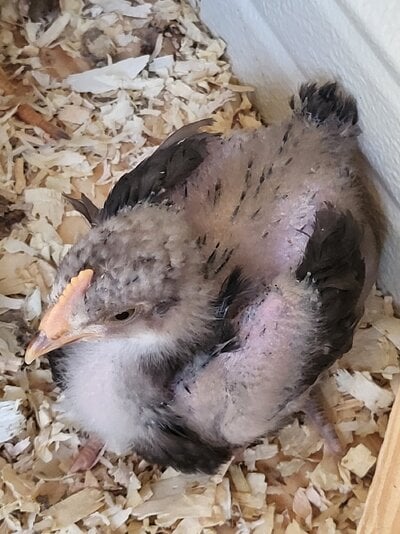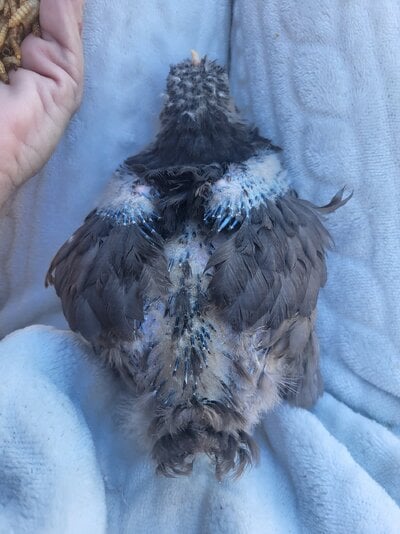The breeder and I are so confused with this one.. These are both chocolate orps (one light, one dark), came from the same breeder and breeding pair.. One chick is 7 weeks old, and the other is 5 weeks.. The 7 week old has a few curled feathers.. The 5 week old is nearly bald, although you can see pin feathers.. They are just coming in verrrrrrrrrrrrrrrry slowly!! I have 31, ages 2-7 weeks, and these are the only two that have "issues".. Feeding Purina non medicated chick starter, they got vitamins and electrolytes for the first week, have plenty of space.. They have access to food/water 24/7.. Pics of the bald one were taken over the past 2 weeks..
Navigation
Install the app
How to install the app on iOS
Follow along with the video below to see how to install our site as a web app on your home screen.
Note: This feature may not be available in some browsers.
More options
You are using an out of date browser. It may not display this or other websites correctly.
You should upgrade or use an alternative browser.
You should upgrade or use an alternative browser.
What is going on?
- Thread starter GreenGoddess
- Start date
Pics
More options
Who Replied?You have a frizzle. The curly feathers are frizzles. I was told they can not breed two chickens that both have the frizzle gene or the chicks can be bald. The hatchery told me that because I bought two frizzles this year. One frizzled the other did not. I'm thinking it's a genetic thing with the frizzle genes. Hope this helps. Ps people love the frizzled look! Even pay more for the chicks.Best wishes!
- Thread starter
- #3
My thinking was frizzle too, but can a chicken be part frizzle? Not all of its feathers are curled, and that's what's so confusing.. I know the breeder does have frizzles, but she keeps all of her breeds separate.. She's as puzzled over these two as I am..You have a frizzle. The curly feathers are frizzles. I was told they can not breed two chickens that both have the frizzle gene or the chicks can be bald. The hatchery told me that because I bought two frizzles this year. One frizzled the other did not. I'm thinking it's a genetic thing with the frizzle genes. Hope this helps. Ps people love the frizzled look! Even pay more for the chicks.Best wishes!
These are both chocolate orps (one light, one dark), came from the same breeder and breeding pair..
I have 31, ages 2-7 weeks, and these are the only two that have "issues"..
Are all of the chicks from the same breeding, or are these the only two?
My first thought is the Slow Feathering gene. As you might expect from the name, it makes chicks grow their feathers very slowly. Some breeds have that gene (I think including at least some Orpingtons), many breeds have the normal Fast Feathering gene, and some breeds can have either one.
I don't know about the curly feathers. Sometimes a chick's first feathers can look a bit odd but later they grow other feathers and look normal. Other times odd-looking feathers are the first sign of something that is not normal. I just don't know in this case.
- Thread starter
- #5
I have 13 from the same breeder, but except for a hen I just got from her today, they are the only 2 chocolate orps I have.. The others are blue laced red wyandottes, light brahmas, dark dramas, and silver laced wyandottes..Are all of the chicks from the same breeding, or are these the only two?
My first thought is the Slow Feathering gene. As you might expect from the name, it makes chicks grow their feathers very slowly. Some breeds have that gene (I think including at least some Orpingtons), many breeds have the normal Fast Feathering gene, and some breeds can have either one.
I don't know about the curly feathers. Sometimes a chick's first feathers can look a bit odd but later they grow other feathers and look normal. Other times odd-looking feathers are the first sign of something that is not normal. I just don't know in this case.
In that case, I'm guessing the Chocolate Orps have slow feathering and the rest don't, but there is always a possibility that it's something else.I have 13 from the same breeder, but except for a hen I just got from her today, they are the only 2 chocolate orps I have.. The others are blue laced red wyandottes, light brahmas, dark dramas, and silver laced wyandottes..
If it is just slow feathering, they will eventually grow a proper set of feathers, and you will never notice it again (unless you hatch chicks from them, in which case the chicks will be slow feathering too.)
- Thread starter
- #7
I hadn't even thought of SFG.. In the past two weeks, it's grown a lot of pin feathers.. These two pics were taken on the 1st, and then today.. Exactly 1 week apart.. I just feel so bad because it's always shivering unless it's under the heat lamp.. Right now, I have it with my 2 week olds.. the first pic, it still had fluff.. Now almost all the fluff is gone, and just pin feathers in their place..In that case, I'm guessing the Chocolate Orps have slow feathering and the rest don't, but there is always a possibility that it's something else.
If it is just slow feathering, they will eventually grow a proper set of feathers, and you will never notice it again (unless you hatch chicks from them, in which case the chicks will be slow feathering too.)
Attachments
I would normally say Slow Feathering gene too. I've raised English Orpingtons that took forever to feather in and looked really funny doing it. But I am a little concerned by the arrangement of feathers on yours. It already has all the wing feathers and some shoulder feathers, but a bare back... Some of the quills look a little odd. It could still be Slow Feathering, in which case everything will be fine... but I'd also watch to see that other chicks are not plucking it. As sometimes a less feathered chick can become a target.
I also found it helpful to feed a higher protein chick feed. Not a lot helpful, but enough to be worth trying. There's one I like by "Flock Party" brand (Manna Pro), they normally make treats, but this is a chick starter with 22% protein. They also really love the taste! Found at TSC. I'm not sure what other chain stores might carry for higher protein Starter.
Do they show signs of excessive itchiness? It can be hard to tell with chicks because their feathers coming in and changing out 5 times is really annoying for them so they groom a lot, but they can still get depluming lice just like adults can.
The one with feathers sticking out isn't frizzled, but looks like it has a feather quality issue. Sometimes it's just a little stage and then they look fine (remember, they get to change their coat 5 times before they're grown). Some of the others also have a ratty appearance, close to the feather shredding gene but probably not that. Really, my first instinct is to say "low protein"... are you giving them a lot of treats?
I also found it helpful to feed a higher protein chick feed. Not a lot helpful, but enough to be worth trying. There's one I like by "Flock Party" brand (Manna Pro), they normally make treats, but this is a chick starter with 22% protein. They also really love the taste! Found at TSC. I'm not sure what other chain stores might carry for higher protein Starter.
Do they show signs of excessive itchiness? It can be hard to tell with chicks because their feathers coming in and changing out 5 times is really annoying for them so they groom a lot, but they can still get depluming lice just like adults can.
The one with feathers sticking out isn't frizzled, but looks like it has a feather quality issue. Sometimes it's just a little stage and then they look fine (remember, they get to change their coat 5 times before they're grown). Some of the others also have a ratty appearance, close to the feather shredding gene but probably not that. Really, my first instinct is to say "low protein"... are you giving them a lot of treats?
- Thread starter
- #9
I've only started giving them treats over the past week.. Before then, they were strictly indoors.. Once they were out in the run for a few hours a day, I started giving them dried meal worms and today they tried strawberries..I would normally say Slow Feathering gene too. I've raised English Orpingtons that took forever to feather in and looked really funny doing it. But I am a little concerned by the arrangement of feathers on yours. It already has all the wing feathers and some shoulder feathers, but a bare back... Some of the quills look a little odd. It could still be Slow Feathering, in which case everything will be fine... but I'd also watch to see that other chicks are not plucking it. As sometimes a less feathered chick can become a target.
I also found it helpful to feed a higher protein chick feed. Not a lot helpful, but enough to be worth trying. There's one I like by "Flock Party" brand (Manna Pro), they normally make treats, but this is a chick starter with 22% protein. They also really love the taste! Found at TSC. I'm not sure what other chain stores might carry for higher protein Starter.
Do they show signs of excessive itchiness? It can be hard to tell with chicks because their feathers coming in and changing out 5 times is really annoying for them so they groom a lot, but they can still get depluming lice just like adults can.
The one with feathers sticking out isn't frizzled, but looks like it has a feather quality issue. Sometimes it's just a little stage and then they look fine (remember, they get to change their coat 5 times before they're grown). Some of the others also have a ratty appearance, close to the feather shredding gene but probably not that. Really, my first instinct is to say "low protein"... are you giving them a lot of treats?
I was thinking about giving extra protein as well, so I will definitely try that.. They are all good as far as lice/mites.. I even double checked the half bald one today just to make sure.. Dry skin, yes, but no creepy crawlies thankfully!
New posts New threads Active threads
-
Latest posts
-
-
-
-
Goose with foot puncture, not an emergency
- Latest: The Prancing Raptor
-
Latest threads
-
Goose with foot puncture, not an emergency
- Started by The Prancing Raptor
- Replies: 0
-
-
-
-
-
-
Threads with more replies in the last 15 days
-
Checking-In On Peeps - Post Here To Say Hello!
- Started by Nifty-Chicken
- Replies: 2K
-
-
-
Can I get some help from someone with careless neighbours who own dogs.
- Started by RiDaGeckoGuy
- Replies: 103
-
-

